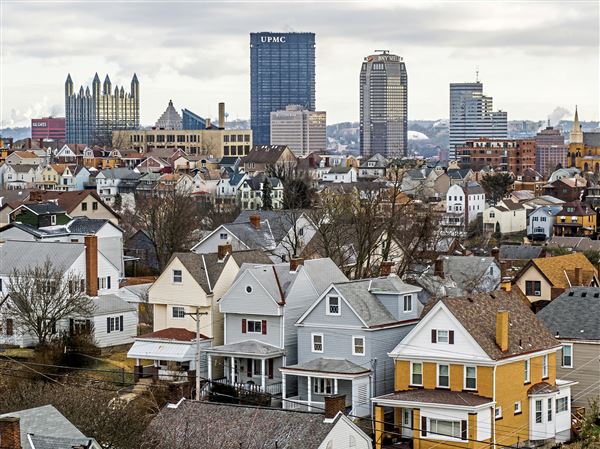While Pittsburgh never had a housing price bubble, the region suffered a foreclosure crisis along with other major cities where real estate values did rise to a peak and then crash back down to earth.
What made Pittsburgh vulnerable to the mortgage meltdown is that banks had been generous with mortgage capital across the nation, and many people here lost homes they had lived in for years due to equity loans they took out against their property and could no longer repay due to job loss, medical illness or the onerous nature of the loan.
Senior citizens, working-class people and African-American families across Allegheny County fell prey to home improvement scams and second mortgages for new cars and vacations. Some of them did it with traditional mortgages while others became victims of predatory lenders who offered cash-out refinancings at sky-high interest rates.
“What we saw was wealth stripped from people who had built it in their homes,” said Ernie Hogan, executive director of the Pittsburgh Community Reinvestment Group based in the Hill District. “We didn’t see the overexaggeration in price of houses, but we did see people who might have been in their homes for many years lose that wealth through the foreclosure process and subprime lending.
“We didn’t have the property appreciation, but we did have the availability of mortgage capital, and a lot of that was subprime.”
In the years since the national housing market collapsed in 2008, PCRG found that the distribution of mortgage capital flowing into Pittsburgh neighborhoods is vastly different today from what it was prior to the crisis.
Majority white and affluent neighborhoods have captured the lion’s share of new mortgage money, while neighborhoods that are mostly minority or with low- or moderate-income residents have been left behind.
For instance, half of the total $960 million in residential loan dollars that banks approved for homebuyers in the city of Pittsburgh in 2012 went to only seven neighborhoods: Shadyside, Squirrel Hill South, Squirrel Hill North, Point Breeze, the Strip District, Southside Flats and Highland Park.
At the other end of the spectrum, the 46 neighborhoods that received the least amount of money captured only 10 percent of all residential mortgage dollars in 2012. Homewood West and Chateau received no mortgage loans at all.
Other neighborhoods that ranked near the bottom in terms of total mortgage loan dollars captured and in the number and dollar amount of loans per unit of housing included Allentown, Bedford Dwellings, California-Kirkbride, East Hills, Homewood North, Homewood South, Larimer, Middle Hill, Mount Oliver/St. Clair and Terrace Village.
To put things in perspective, all of Homewood had 16 residential mortgages in 2012, Squirrel Hill had 767 mortgage loans that year and Shadyside had 371.
Interestingly enough, while the number of mortgages have declined in all census tracts, the total dollar amounts of the loans have increased.
The mortgage lending study covers eight years from 2005 to 2012 and looks at all residential mortgage lending data for Allegheny County, including all financial institutions that do mortgage lending here, even banks that do not have physical branch offices here but make loans in Pittsburgh.
The PCRG is a watchdog organization that holds the banking industry accountable for its lending practices, especially in low-income communities. The organization has examined mortgage lending trends annually for 20 years looking at a respective year that’s gone by, but this year the researchers wanted to compare data for the years prior to the mortgage meltdown to see what the lending trends in Allegheny County were then and today.
“The recovery for majority-white and affluent neighborhoods started in 2009,” said Rachel Rue, the lead researcher at PCRG. “The recovery has been slow for minority neighborhoods and low- and moderate-income neighborhoods. The recovery for those neighborhoods has only just started, and it has not gotten very far.”
The Department of Housing and Urban Development each year publishes estimates for the median family income for a region, which in 2012 was $64,900 for Allegheny County. Families classified as low-income earn less than 50 percent of the median, which in Allegheny County is less than $32,450. Moderate-income families earn between 50 percent and 80 percent of the median, which is between $32,450 and $51,920.
Another trend the PCRG found, which could be related to the fact that the economic crisis hit much harder in nonwhite and lower-income communities, is that mortgage loan denial rates for mortgages originating in minority and low- and moderate-income neighborhoods were twice as high or more than those originated in white and higher income census tracts.
The mortgage denial rate for all of Allegheny County in 2012 was 22 percent. For majority-minority neighborhoods, the denial rate was 46 percent. Upper-income neighborhoods had a mortgage denial rate of 19 percent in 2012. Low- and moderate-income neighborhoods had a 38 percent denial rate that year.
Ms. Rue said the disparities in denial rates actually got worse during the recovery from the mortgage crisis.
“As we started to recover and the mortgage lending numbers started coming up, the difference in denial rates got bigger,” Ms. Rue said. “So in 2012, that disparity in denial rates was as high as it’s ever been since the study started.”
Some reasons for the growing gap could be that the economic situation for a lot of people living in low- and moderate-income and minority communities is worse. Credit is harder to secure, and debt-to-income requirements are higher.
Howard “Hoddy” Hanna, president and CEO of Howard Hanna Real Estate Services, said he is not surprised by the study’s findings.
He said the difficulty many working-class borrowers face now stems from the Dodd-Frank Wall Street Reform and Consumer Protection Act of 2010, which requires lenders to more closely scrutinize borrowers’ financial information to make sure they can afford a mortgage.
One of the provisions prohibits banks from approving mortgages for anyone whose debt-to-income ratio is higher than 43 percent. Banks used to be able to approve borrowers with a ratio of around 50 percent or even higher. Credit score requirements also have gone from around 570-580 to around 640-650.
“The provisions in the Act makes it very difficult for lenders to lend money to low- and moderate-income borrowers,” Mr. Hanna said. He pointed out that financial institutions in the business of originating mortgages they plan to resell on the secondary market must meet standards for government sponsored buyers like Fannie Mae and Freddie Mac and other big banks.
“It hurts moderate-income borrowers because credit scores are not there and down payments are not there,” Mr. Hanna said. “To me it’s an overreaction to the financial crisis. I think it’s unfair to people who would be good home buyers.
“With most folks, at the end of the day their largest asset is the equity in their house. We are taking a whole generation of qualified people and holding them back now and discounting them from the American Dream and the opportunity to build equity in a house for the future.”
First Published: July 27, 2014, 4:00 a.m.














